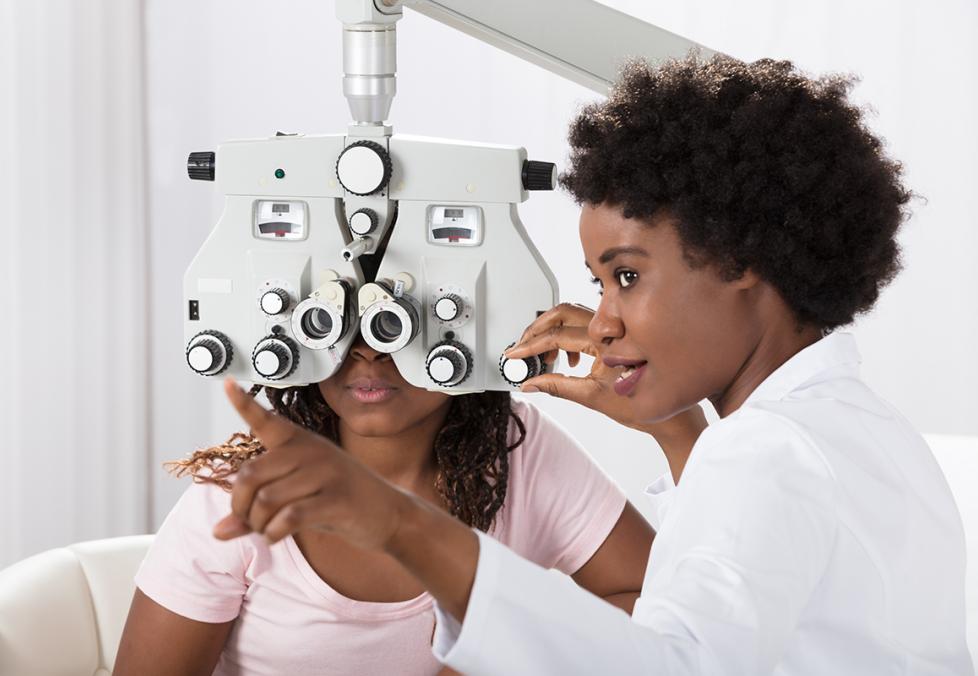
Two pairs and a free, quality eye exam for just $79.95
Everything you need to know to take care of your eyes — for life.
Your eye doctor can’t order your contact lenses until you return for a contact lens follow-up exam. Here’s what it is, and why it’s so important.

So, you’ve had your contact lens exam, learned how to insert and remove a pair of lenses, and headed home with clear vision.
But you’re not quite done yet.
Included in every America’s Best contact lens exam is a follow-up contact lens exam. That’s when you return to your optometrist’s office so that they can examine your eyes again — this time while you’re wearing your temporary diagnostic lenses.
In fact, this follow-up exam is so important that your eye doctor can’t order your new contact lenses until you’ve completed it.
Here’s everything you need to know about contact lens follow-up exams, and why they are so crucial for your eye health.
Did you know that contact lens prescriptions need to be renewed every year? Find an exam time that fits your schedule.
If you wear contact lenses (or want to start), you’ll need a contact lens exam. It’s slightly different than a regular eye exam. That’s because your eye doctor needs to take measurements of your eyes to fit you for contact lenses and make sure your eyes produce enough tears to keep your lenses moist. (Learn more about how these two important eye exams differ here.)
At the end of your contact lens exam, you’ll receive a pair of diagnostic contact lenses to take home. You’ll wear them for about a week before returning to your optometrist’s office for your contact lens follow-up exam.

Two pairs and a free, quality eye exam for just $79.95
During your follow-up exam, your optometrist will examine your eyes to check the fit and prescription of your contacts. They will also make sure your contact lenses feel comfortable.
The diagnostic pair of contact lenses you’ve been wearing may have felt comfortable when you first put them in. But after a few hours or days of wear, they may feel different. If the lenses don’t feel comfortable in your eyes, your optometrist may recommend different brands and types of contact lenses you can try next.
A follow-up exam is typically about one week from your original appointment, says Jennifer Mai, O.D, an optometrist at America’s Best Contacts & Eyeglasses in Stone Mountain, Georgia. But if you experience any pain or eye issues during that time, call your optometrist’s office right away, she says.
Important tip: The follow-up exam (or exams, if you end up needing more than one) is included in the contact lens exam fee at America’s Best. Just make sure it’s within 45 days of the original exam date.
“The hidden goal of these exams is to catch any issues early on and prevent long-term health complications,” says Dr. Mai.
Unlike eyeglasses, contact lenses sit directly on your eye. A lens’s material, design, or fit can cause discomfort, dryness, and pain. Poor-fitting contact lenses can even lead to more serious issues, such as a scratched cornea or corneal ulcer.
“Contact lens wearers are generally at higher risk for infections and ocular health complications than non–contact lens wearers, simply because they are putting a foreign body in their eyes,” says Dr. Mai.
Before you go for your contact lens follow-up, Dr. Mai suggests making a note of any issues you’ve noticed, so that you can bring them up with your eye doctor.
The key is to be mindful of how you’re feeling (and seeing). If you can see clearly and your contact lenses feel comfortable all day, that’s great. But if you can only go a few hours before your eyes start to feel irritated or strained, it might be a sign you need to try a different brand or type of contact lens.
It’s also a good idea to tell your optometrist about any vision problems you’ve noticed while wearing your contact lenses, such as having trouble driving at night or seeing your computer screen.
“With any comfort or vision issue, note the frequency and associated activity,” says Dr. Mai.
Another tip? Show up to your follow-up exam with your lenses having been in your eyes for a few hours. “We want to see how the lenses have settled in, and to better simulate how the contact lens sits throughout your day,” says Dr. Mai.
During your contact lens follow-up exam, your optometrist will check your eyes and assess your vision while you’re wearing your diagnostic lenses.
They will help decide if your contact lenses are right for you by asking you questions like:
Your eye doctor will also want to know what kind of rewetting drops and multipurpose solution you’ve been using. You can take photographs of the bottles or even bring the bottles with you to your follow-up appointment.
It’s important to make sure your contact lens care products are right for your lenses. According to the American Optometric Association, not all lens materials and contact lens solutions are compatible, and that could potentially affect the disinfection process. Switching to a different contact lens solution may also cause dry eye.
Your optometrist will also take a close look at both of your eyes using a slit lamp. This is a microscope that looks at your eye and allows your doctor to see if your contact lenses fit well. Poor-fitting contact lenses can cause eye pain, blurry vision, and other serious complications, including oxygen deprivation at the cornea.
“The eyes get oxygen from the air during the day, so it’s important to make sure they continue to receive good oxygen flow,” says Dr. Mai.
If your optometrist determines that your contact lenses are a good fit, they will order your new lenses and let you know when you can pick them up.
But if your contact lenses aren’t comfortable or you can’t see well, your optometrist will recommend a different brand or type of contact lenses. They will give you a new trial pair, which you’ll wear for a week or so before returning for another follow-up exam. The process will be repeated until your eye doctor is certain you have the perfect contact lenses for your eyes.
See our sources
Contact lens safety tips: U.S. Food & Drug Administration
How to care for your contact lenses: American Optometric Association
More contact lens care strategies: American Academy of Ophthalmology
Corneal abrasion overview: American Optometric Association
Tight lens syndrome overview: Tufts Medical Center
Slit lamp exam overview: University of California San Francisco
Common contact lens mishaps: University of Utah Moran Eye Center